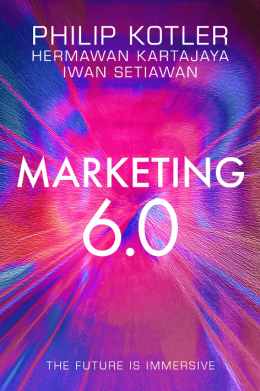
Marketing Series – Marketing 6.0 – The Future Is Immersive – Web Tải Sách Miễn Phí Ebooks PDF
Giới thiệu & trích đoạn ebook
Sách Marketing Series – Marketing 6.0 – The Future Is Immersive của tác giả Philip Kotler, Hermawan Kartajaya, Iwan Setiawan mời bạn thưởng thức.
CHAPTER 2
The Emergence of Phygital Natives: Young Generation Z and Generation Alpha Coming of Age
In the last decade, marketers have favored Generation Y, or the millennials, as a focus audience due to their sheer size and high purchasing power. Consequently, marketers have adjusted their strategies to adapt to Generation Y’s key characteristics, such as a strong focus on sustainability and tech savviness.
Modern marketers have created more campaigns highlighting eco‐friendly products or socially responsible operations. For example, fashion brands such as Patagonia and Everlane have tapped into the millennial mindset by focusing on recycled and sustainably produced materials and becoming the antithesis of the fast fashion industry.
Marketers have also leveraged digital marketing tactics such as social media and search engine marketing to reach Generation Y. Even luxury fashion groups such as LVMH and Kering, traditionally known for investing heavily in offline experiences, have shifted half of their marketing budget to digital media. This shift toward digital marketing has allowed these brands to reach a wider audience of millennials.
Marketing strategies have evolved to become more sustainable, digital, and social to cater to the increasing influence of millennials. However, it does not stop there, as marketers are expanding their efforts to engage with even younger generations: Generation Z and Generation Alpha.
Embracing Phygital Natives
Today, marketers increasingly focus on Generation Z and Generation Alpha, true digital natives who grew up with the mainstream Internet. Generation Z, born between the mid‐1990s to early 2010s, was born into the digital age and is highly adaptable to new technologies. Generation Alpha, the following cohort born after 2010, is expected to be even more digitally savvy due to growing up with millennial parents who are also tech‐savvy. Together, they account for more than four billion people globally, making them a key market for brands.
Although they share some similarities with Generation Y in digital savviness, some differences set Generation Z and Generation Alpha apart (see Figure 2.1). Generation Y, experiencing the Internet later in life, often views it as a mere tool. In contrast, Generation Z and Generation Alpha, who have grown up with the Internet as a constant presence, consider it an integral part of their daily experience. They are connected continuously through multiple screens, even in social situations. As a result, these younger cohorts have a higher level of immersion in digital environments. Marketers, therefore, have to rethink ways to engage with them.
Due to a lifetime of immersion in digital stimulation and massive messages targeted their way, Generation Z and Generation Alpha have selective attention spans. It has resulted in a preference for personalized content and a tendency to ignore irrelevant messages. They also skip longer advertisements and prefer short‐form content, memes, and emoji.
Yet they can spend hours binging on Netflix and be deeply absorbed in playing online games with their friends. It suggests they have no problem sustaining their attention span when the content is highly engaging and personalized to their interests.
TikTok’s rise exemplifies this. The popularity of its short‐form format and robust personalization algorithm among Generation Z prompted Instagram and YouTube to follow suit with their versions called Reels and Shorts, respectively. These new platforms accommodate selective attention, allowing them to scroll short‐form content endlessly on social media. The preference for brief, visual content also extends to Internet search behavior, with Generation Z favoring platforms such as YouTube, Instagram, and TikTok over traditional browsing on Google.
We could argue that this strong preference for hyper‐personalized content means that Generation Z and Generation Alpha are artificial intelligence (AI) natives. While they do not necessarily understand AI technology more than other generations, they grew up seeing the value of sharing their data in exchange for more contextual and personalized experiences.
Moreover, they are comfortable interacting with AI‐powered voice assistants such as Apple’s Siri or Amazon’s Alexa to make their lives more convenient. Students and young professionals are beginning to actively use ChatGPT or similar language models to help with school and office work. Some even prefer chatbots to human customer service representatives to handle quick inquiries and complaints.
Generation Z and Generation Alpha are also metaverse natives. Their love for online gaming suggests they are comfortable with immersive digital environments and virtual communities. Gaming is popular for these generations, who are drawn to the highly immersive digital content, engaging competition with peers, and tightly knit online communities that gaming offers.
While Generation Y like to gather in person when gaming, Generation Z and Generation Alpha tend to connect remotely in virtual gaming environments. The younger cohorts are also more likely to spend money buying in‐game items to enhance their avatars and improve their gaming experience. In addition, they are comfortable interacting with user interfaces that use augmented reality (AR) and virtual reality (VR) technologies.
Nevertheless, engaging younger generations does not necessarily mean focusing solely on online experiences. In fact, recent research shows that Generation Z, despite being known as digital natives, still enjoys shopping in physical stores. A McKinsey survey across 25 product categories reveals that, although Generation Z in the United States makes many online purchases, they are also more likely to shop in physical stores than Generation Y.
Likewise, research by A.S. Watson—the world’s largest health and beauty retail group—shows that Generation Z prefers offline shopping for beauty products, citing physical stores’ social interactions and experiential aspects as key attractions. Moreover, Generation Z also seeks technology‐enhanced physical stores and online‐offline integrated apps for a more immersive and seamless shopping experience.
Sách liên quan

Donate Ủng hộ chúng tớ 1 ly cafe
Nhằm duy trì website tồn tại lâu dài và phát triển, nếu bạn yêu thích Taiebooks.com có thể ủng hộ chúng tớ 1 ly cafe để thêm động lực nha.
Bạn cần biết thêm lý do để ủng hộ Taiebooks.com ?
- Website cần duy trì tên miền, máy chủ lưu trữ dữ liệu tải ebook và đọc online miễn phí.
- Đơn giản bạn là một người yêu mến sách & Taiebooks.com.










